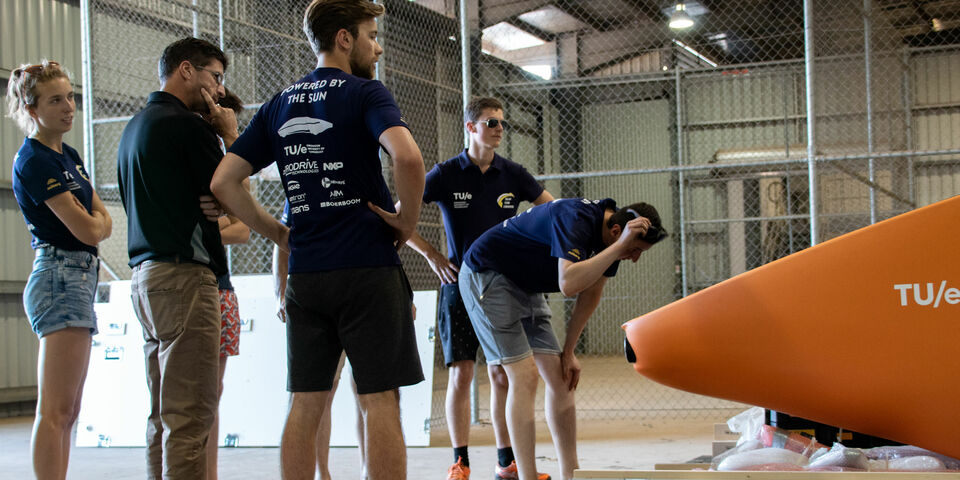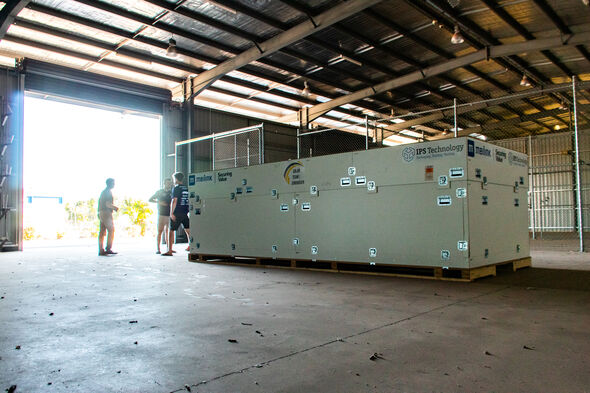TU/e solar car will appear at the start despite damage
Solar Team Eindhoven expects to participate in the Bridgestone World Solar Challenge in Australia next month as planned, despite serious transport damage to the solar roof of its car. Whether the expected lower efficiency (and consequently, lower energy gain) of one of the car’s solar panels will stand in the way of the TU/e team’s fourth world title remains to be seen.
Reuniting with ‘their’ Stella Era in the far north of Australia last Thursday turned out to be a disappointing experience for the TU/e students. Transport had gone as planned as far as the timeframe was concerned, unlike two years ago when the solar car and battery arrived in Darwin with more than three weeks delay - “that’s why we were a bit concerned this time around as well,” says PR manager Marijke Sesink.
But Thursday, with the final kilometers of the traditional reversed training trip from Adelaide to Darwin ahead, the team received some alarming news: the solar car had arrived at the team’s home base exactly as planned, but the box that was used to ship the car had been damaged during transport.
“Of course, the news came as a shock,” Sesink says on Sunday over the phone. “But damage to the exterior doesn’t necessarily mean that the interior is damaged as well.” Some of the team members immediately went out to investigate the damage after their arrival in Darwin, and at first sight “they were quite worried. Part of the box was skewed, and some of the clips had come loose - as if it had been hit hard by something from one side.”
Firmly secured with buckles
Sesink says that the solar car is packed up in the box in the same way as it is adjusted onto the trailer: firmly secured with buckles applied to the car’s suspension - “it can’t move an inch during transport.” The same applies to other equipment in the same box. After the team dismantled the box, Stella Era at first didn’t appear to have suffered any serious damage, until the heavy protective cover was lifted from the solar roof.
It turned out that one of the panels on the rear of the roof, at the car’s tail, was severely damaged. Judging by the kind of damage, Sesink has little doubt as to what caused it: one of the wooden beams inside the box. The team hopes to reconstruct part of the journey from the Netherlands to Australia together with its transport partner: “We should have access to photographs that were taken during several stops.”
The team faces an additional setback: the damaged panel also happened to be the most efficient part of the solar roof. “We test every cell in advance; naturally, the manufacturer promises a certain level of efficiency, but we also check that ourselves.” Based on the results of those tests, the cells are grouped and distributed among the several different panels that make up the roof of the car. “The rear of the car captures much sunlight, so that’s where we place the most efficient cells.”
Vulnerable
During the next few days, the team hopes to learn which of the cells of the damaged panel they can possibly still use. Sesink is afraid to be too optimistic: “Those solar cells are incredibly vulnerable. It’s very difficult to take them apart and put them back together once they’ve been assembled.” The team brought a standard spare solar panel, “but the cells on that panel are the ones with the lowest efficiency. We naturally assumed that we wouldn’t have to use it.”
The team will have to make some important decisions during the next few days, Sesink says. “We hope to have the car back on the road before our first testing day on September 16.” On October 7, the day of the so-called static scrutineering, all participating cars will be thoroughly reviewed by officials of the Bridgestone World Solar Challenge for the first time.
Anyone who thinks that the team still has all the time in the world, is mistaken; the TU/e students will need every minute of those next four weeks. Apart from the damage caused by the transport, they still need to do a great deal of work on the car; specifically on the battery, which also has arrived by now and still needs to be assembled and tested. “But several other parts need to be installed and tested as well, so that we can go out on the road with a dependable car.”
New regulations
Sesink says that as yet the damage to the panel has not put the team’s participation at risk. “But there is some anxiety over exactly how much we will lose in terms of energy gain.” Does Solar Team Eindhoven still even think about a fourth world title at all? Sesink doesn’t really speak out: “There are many new regulations this year anyway, and 'practicality' will play a much more important role. However, it really is very difficult to predict our chances.”
Sesink says that, despite the recent setback, the team remains “quite positive actually. We had a bit of a scare and it was stressful, but we didn’t stay stuck in our problems and immediately started looking for solutions.” The team also got a boost from the many supportive and encouraging responses it received after going public with the news, she says. “We aren’t here just for ourselves, but for our fanbase back home as well to a certain extent. So, everyone makes an extra effort.”
The team from Eindhoven was offered support and help from other participating teams as well. “That really is typical of the atmosphere here. Everyone here wants to win, but we also have a shared objective: to show the world that we can build a solar can that can drive three thousand kilometers through the Australian outback. And you help each other with that.”






Discussion